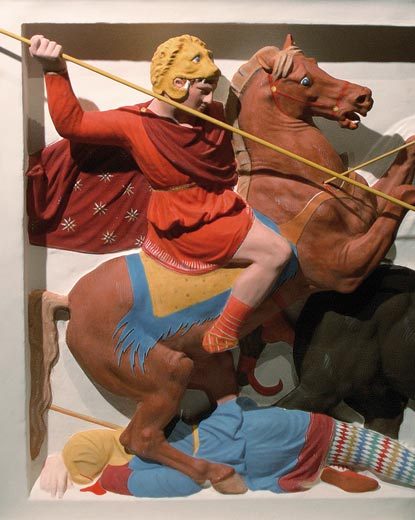I always love seeing this fact pop up. Yeah, what we thought was the ancients just being really cool and aesthetic was actually the gaudy colors fading away over time. It’s like when people think that old houses were built better than they are now, when it’s really just that the shitty houses all fell down already.
Ummmm but the problem is not so much that they weren’t being “cool and aesthetic”; it’s that this entire western concept of aesthetics is built on a mistake.
The ask was in response to this article, which makes it 200 times funnier.
fittingly, I was just reading this:
The Parthenon marbles Elgin took to Britain do consist of marble, but a darkly pitted Greek marble rather than the smooth, snowy white variety more common in Italy. Here lay an aesthetic problem: whiteness versus color. The alarming history of European marble “cleaning” includes a chapter on this statuary describing a drive to make ancient Greek art white that nearly destroyed the art itself. In the 1930s workers in the British Museum were directed to remove the dark patina with metal tools on the mistaken assumption that their proper color should be white. Such a “cleaning” seriously damaged the Parthenon marbles, prompting an inquiry by the museum’s standing committee that halted the work.
—Nell Irvin Painter, The History of White People, page 63
It’s particularly obnoxious given the claims by so many British people that the marbles had to be removed to Britain in order to protect them.
The bold: People should really know about that, too.
And yes, it is connected with this article about Chromophobia and colonialism
which is also connected to the Reformation.
Especially if you think about (at least in an American context) the way that Catholicism has been, to a large degree, racialized. And how the Catholic Mass and other traditions came to be associated with licentiousness and was condemned for its use of decoration (aside form legitimate gripes with corruption).
see also: Calvinist Iconoclasm:
OMG!!! I FORGET PEOPLE DON’T KNOW THIS!
Yes, all those aloof, “pure” white statues from Ancient Greece?
They actually looked like this:
Vinzenz Brinkmann, much to the apparent chagrin of Westerners everywhere, used ultraviolet light to reveal the original paint schemes of these statues that the millennia had washed away.
And to underscore the Chromophobia?
Check out this graphic that i09 made for their leading image for this story:
In the summer of 1566, spurred on by the sermons of Calvinist preachers, zealous mobs descended on churches in the Netherlands, intent on ridding them entirely of their imagery. Many churches were literally white-washed.
All of these things are connected.
reblogging for someone who recently asked about this.
Someone also asked about over-cleaning or modifications made to various Greek and roman works in European Possession.
British Museum: Over-Cleaning of the Elgin Marbles
British Museum: Public Response
Like, they were literally dipping them in acid to make them “pure and white” as they imagined they were “originally”.
Medieval churches in England also suffered from a similar problem. Originally they were covered in murals, floor to ceiling, in the gaudiest colours they could manage. Part of it was probably to engage the illiterate population with a giant devotional picture book.
Here’s a snippet from one I studied in the Deanery of Durham Cathedral:
Then along came the Reformation with its accusations of idolatry, its desire for direct book learning for everyone and its general drive to
make everything boringremove the distractions of the material world.In some churches, they chipped the images off the walls, but in many they just white-washed over them.
Which would be fine for us, since layers of white-wash can be removed to reveal the original paintings, as happened in the Deanery and as happens around the UK by accident on a regular basis, where the old white-wash is still in place.
But alas, the Victorians happened. They saw the bare stones of the thoroughly defaced churches and thought they had more grandeur than the white-washed or ,worse, the still painted churches, and so set about ‘restoring’ the churches of England.
Granted, compared to the art of the renaissance and the classical greek world, the English medieval murals do look like crude kiddy scribbles, offensive to the Victorian (and modern) sense of taste and not at all what they wanted in their monumental architecture. But they were the medieval decoration, like it or not.
‘Victorian Restoration’ is a well-known oxymoron in old architectural nerd circles. The walls of many churches were stripped back to the stone and in some cases, beyond. The entire outer surface of Durham Cathedral was chipped off (I forget the exact depth, some small number of centimetres), to make it ‘clean’.
But yeah, prior to the Reformation, the British Isles loved colours. There were the sumptuary laws, in which the nobility tried to keep the wearing of awesome colours to themselves when rich commoners started to get in on the deal. There were the bardic rules in Ireland, where the higher rank a bard you were, the more colours you got to wear. And then there was the amazing rivalry between blue dye merchants and red dye merchants (you know why devils were painted as red? Because the blue dye merchants were slandering the red dye merchants.)
But alas, the Victorians Happened=best paragraph intro since everything changed when the Fire Nation attacked

Just another WordPress site




